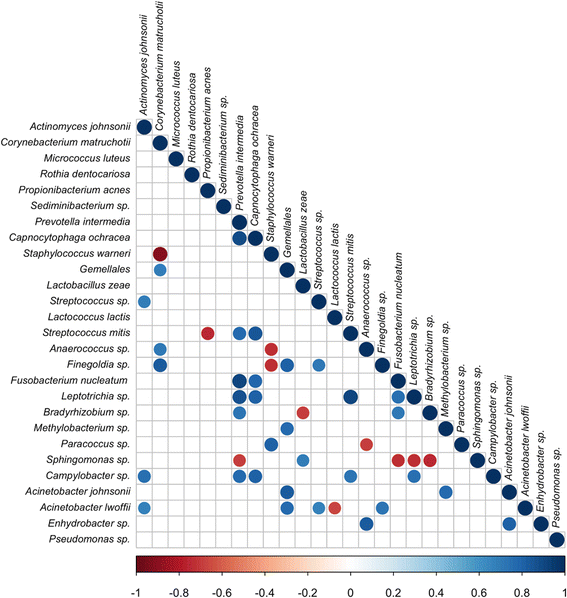Apical periodontitis: preliminary assessment of microbiota by 16S rRNA high throughput amplicon target sequencing
- PMID: 29609564
- PMCID: PMC5879750
- DOI: 10.1186/s12903-018-0520-8
Apical periodontitis: preliminary assessment of microbiota by 16S rRNA high throughput amplicon target sequencing
Abstract
Background: Apical periodontitis includes periapical granulomas and radicular cysts, which are histologically distinguished by the absence and the presence of an epithelial lining, respectively. The main cause of apical periodontitis is the bacterial colonization of the root canal space. This research aimed at assessing whether and how periapical granulomas and radicular cysts differ in terms of microbiota using high throughput amplicon target sequencing (HTS) techniques.
Methods: This study included 5 cases of Periapical Granulomas (PGs) and 5 cases of Radicular Cysts (RCs) selected on the base of histology out of 37 patients from January 2015 to February 2016. Complete medical history, panoramic radiograms (OPTs) and histologic records of each patient were assessed. Only lesions greater than 1 cm in diameter and developed in proximity to teeth with bad prognosis were included. The microbiota present in periapical granulomas and radicular cysts thus retrieved was finely characterized by pyrosequencing of the 16S rRNA genes.
Results: The core of OTUs shared between periapical granulomas and radicular cysts was dominated by the presence of facultative anaerobes taxa such as: Lactococcus lactis, Propionibacterium acnes, Staphylococcus warneri, Acinetobacter johnsonii and Gemellales. L. lactis, the main OTUs of the entire datasets, was associated with periapical granuloma samples. Consistently with literature, the anaerobic taxa detected were most abundant in radicular cyst samples. Indeed, a higher abundance of presumptive predicted metabolic pathways related to Lipopolysaccharide biosynthesis was found in radicular cyst samples.
Conclusions: The present pilot study confirmed the different microbial characterization of the two main apical periodontitis types and shade light on the possible role of L. lactis in periapical granulomas.
Keywords: Apical periodontitis (AP); High throughput amplicon target sequencing; Microbiota; Periapical granulomas (PGs); Radicular cysts (RCs).
Conflict of interest statement
Ethics approval and consent to participate
This study was approved by the Ethics Committee of the Dental School, University of Turin. The cystic formations removed during surgery were subjected to histology as part of the standard care. Written informed consent to participate was obtained from all study participants.
Consent for publication
Not applicable.
Competing interests
The authors declare that they have no competing interests.
Publisher’s Note
Springer Nature remains neutral with regard to jurisdictional claims in published maps and institutional affiliations.
Figures



Similar articles
-
Investigation of cultivable bacteria isolated from longstanding retreatment-resistant lesions of teeth with apical periodontitis.J Endod. 2013 Oct;39(10):1240-4. doi: 10.1016/j.joen.2013.06.018. Epub 2013 Aug 27. J Endod. 2013. PMID: 24041384
-
Macrophage polarization differs between apical granulomas, radicular cysts, and dentigerous cysts.Clin Oral Investig. 2018 Jan;22(1):385-394. doi: 10.1007/s00784-017-2123-1. Epub 2017 May 13. Clin Oral Investig. 2018. PMID: 28501945
-
Differences in Inflammation and Bone Resorption between Apical Granulomas, Radicular Cysts, and Dentigerous Cysts.J Endod. 2019 Oct;45(10):1200-1208. doi: 10.1016/j.joen.2019.06.014. Epub 2019 Aug 7. J Endod. 2019. PMID: 31400944
-
Nonsurgical root canal therapy of large cyst-like inflammatory periapical lesions and inflammatory apical cysts.J Endod. 2009 May;35(5):607-15. doi: 10.1016/j.joen.2009.02.012. J Endod. 2009. PMID: 19410070 Review.
-
New perspectives on radicular cysts: do they heal?Int Endod J. 1998 May;31(3):155-60. doi: 10.1046/j.1365-2591.1998.00146.x. Int Endod J. 1998. PMID: 10321160 Review.
Cited by
-
Diagnostic Test Accuracy of Artificial Intelligence in Detecting Periapical Periodontitis on Two-Dimensional Radiographs: A Retrospective Study and Literature Review.Medicina (Kaunas). 2023 Apr 15;59(4):768. doi: 10.3390/medicina59040768. Medicina (Kaunas). 2023. PMID: 37109726 Free PMC article. Review.
-
The Oral Microbiome of Peri-Implant Health and Disease: A Narrative Review.Dent J (Basel). 2024 Sep 24;12(10):299. doi: 10.3390/dj12100299. Dent J (Basel). 2024. PMID: 39452426 Free PMC article. Review.
-
Autophagy in aging-related oral diseases.Front Endocrinol (Lausanne). 2022 Aug 5;13:903836. doi: 10.3389/fendo.2022.903836. eCollection 2022. Front Endocrinol (Lausanne). 2022. PMID: 35992149 Free PMC article. Review.
-
The Gum-Gut Axis: Periodontitis and the Risk of Gastrointestinal Cancers.Cancers (Basel). 2023 Sep 15;15(18):4594. doi: 10.3390/cancers15184594. Cancers (Basel). 2023. PMID: 37760563 Free PMC article. Review.
-
Comparative Metabolomics Reveals the Microenvironment of Common T-Helper Cells and Differential Immune Cells Linked to Unique Periapical Lesions.Front Immunol. 2021 Sep 3;12:707267. doi: 10.3389/fimmu.2021.707267. eCollection 2021. Front Immunol. 2021. PMID: 34539639 Free PMC article.
References
-
- Poswar FDO, Farias LC, Fraga CADC, Bambirra W, Brito-Júnior M, Sousa-Neto MD, et al. Bioinformatics, interaction network analysis, and neural networks to characterize gene expression of radicular cyst and periapical granuloma. J Endod. 2015;41:877–883. doi: 10.1016/j.joen.2015.02.004. - DOI - PubMed
Publication types
MeSH terms
Substances
LinkOut - more resources
Full Text Sources
Other Literature Sources
Research Materials

